Getting Started
Getting Started with Planton Cloud
From Zero to Deployed Infrastructure in 10 Minutes
Welcome! This guide walks you through your first experience with Planton Cloud—from creating your account to deploying real cloud infrastructure. No prior platform knowledge needed, just follow along step by step.
What you'll achieve: By the end of this guide, you'll have created an organization, connected a cloud account, and deployed your first resource. Real infrastructure, really running, really fast.
Step 1: Sign Up for Planton Cloud
Navigate to the Platform
- Go to planton.ai
- Click either "Login" or "Join Beta" button
Screenshot Placeholder: Planton.ai homepage showing Login and Join Beta buttons
Create Your Account
Both buttons take you to the authentication page. Here's what might be confusing: it's a single page for both login and signup.
- Click the "Sign up" button to switch to registration mode
- Choose your signup method:
- Email & Password: Enter your email and create a password
- Continue with Google: Use your Google account (recommended for faster setup)
Screenshot Placeholder: Signup page showing email/password fields and "Continue with Google" option
- Complete the signup process
- You'll see a "Welcome to Beta" banner
Screenshot Placeholder: Welcome to Beta banner after first login
What happens next: Click "Continue to Platform" to enter the console. You'll land on the dashboard as a new user without an organization.
Step 2: Create Your Organization
Every Planton Cloud journey starts with an organization. Think of it as your company's cloud workspace.
Understanding Organizations
An organization is:
- Your top-level container for everything
- Where you invite team members
- Where billing is managed
- Similar to a Google Cloud organization
As the creator, you automatically become the organization owner.
Create Your First Organization
- On the dashboard, you'll see a prompt to get started
- Click "Create Organization"
- Fill in the details:
- Organization Name: Human-friendly name (e.g., "Acme Corp" or "My Startup")
- Organization ID: Unique identifier, lowercase with hyphens (e.g., "acme-corp" or "my-startup")
Screenshot Placeholder: Create Organization form with name and ID fields
- Click "Create"
Success! Your organization is created and automatically set as your active context. You'll see it in the context selector (top-left, next to the logo).
Step 3: Create Your First Environment
Environments separate your resources (think dev, staging, production). All infrastructure deploys to environments, not directly to organizations.
Create a Development Environment
- With your organization selected, look for environment creation options
- Click "Create Environment"
- Enter environment details:
- Name: Start with "development" or "dev"
- Requirements: Lowercase, alphanumeric, hyphens only
Screenshot Placeholder: Create Environment form
- Click "Create"
Your environment is created and set as the active context. The context selector now shows:
Your Org Name / development
Step 4: Connect Your Cloud Account
Before deploying infrastructure, connect your cloud provider account. This gives Planton Cloud permission to create resources on your behalf.
Navigate to Connections
- Click "Connections" in the sidebar
- You'll see cards for various providers:
- Cloud: AWS, GCP, Azure, DigitalOcean, etc.
- Git: GitHub, GitLab
- Registries: Docker, ECR, GCR
- Others: Kubernetes, Terraform backends

Connect AWS (Example)
Let's connect an AWS account:
-
Click "Connect" on the AWS card
-
Fill in your AWS credentials:
- Access Key ID: Your AWS access key
- Secret Access Key: Your AWS secret key
- Region: Default region (e.g., us-east-1)
-
Critical Step: Select authorized environments
- Check the box next to "development"
- This allows the environment to use these credentials
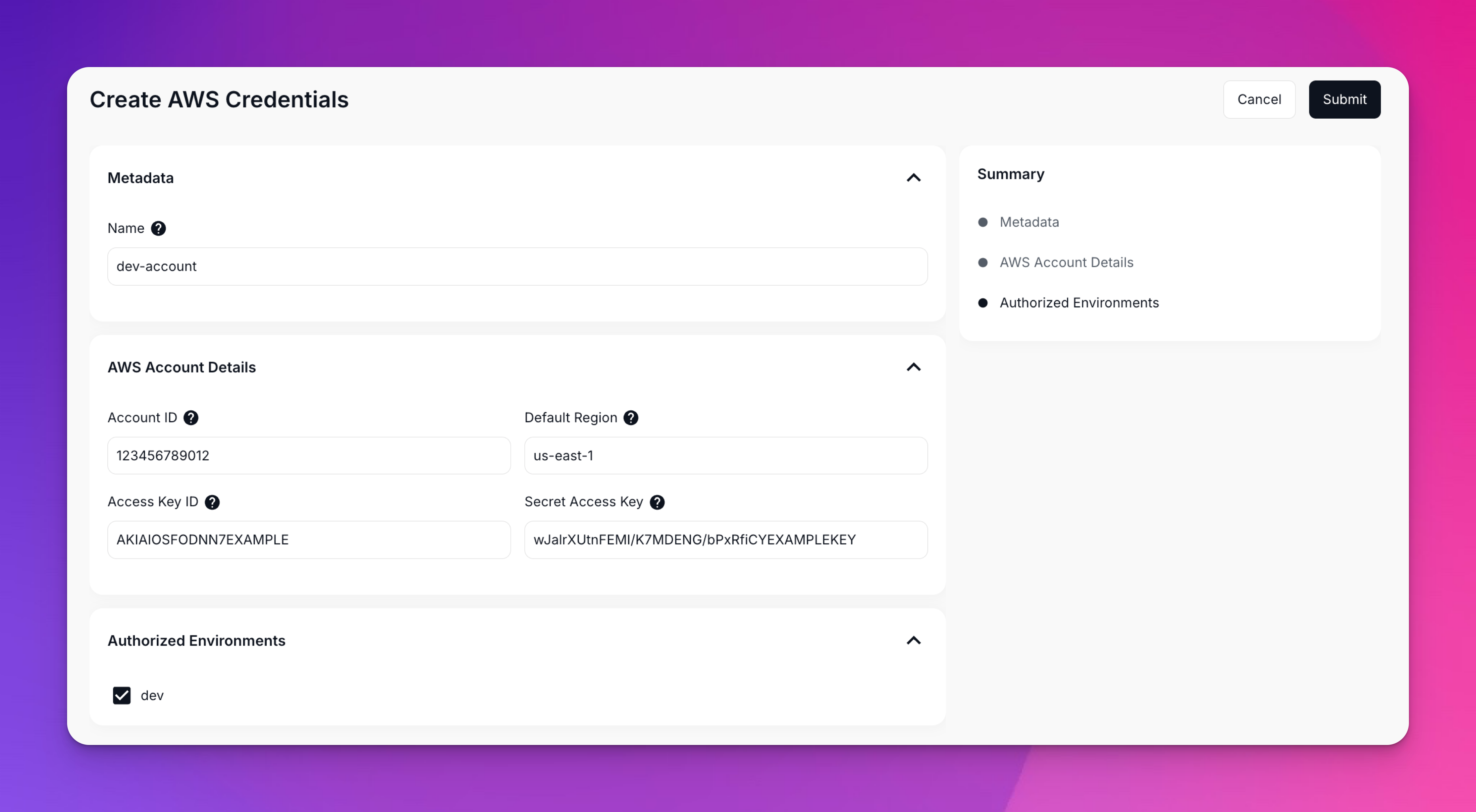
- Click "Submit"
Success! Your AWS account appears in "Existing Connections" and is ready to use.

Connect Other Providers
The process is similar for other providers:
- GCP: Upload service account key JSON
- Azure: Provide subscription and service principal details
- GitHub/GitLab: OAuth flow for repository access
Step 5: Deploy Your First Resource
Now for the exciting part—deploying real infrastructure! We'll start with something simple but useful: a VPC (Virtual Private Cloud) on AWS.
Browse the Component Store
- Click the Deployment Component Store icon in the header (right side)
- You'll see two tabs:
- Lego Blocks: Individual resources
- Infra Charts: Collections of resources
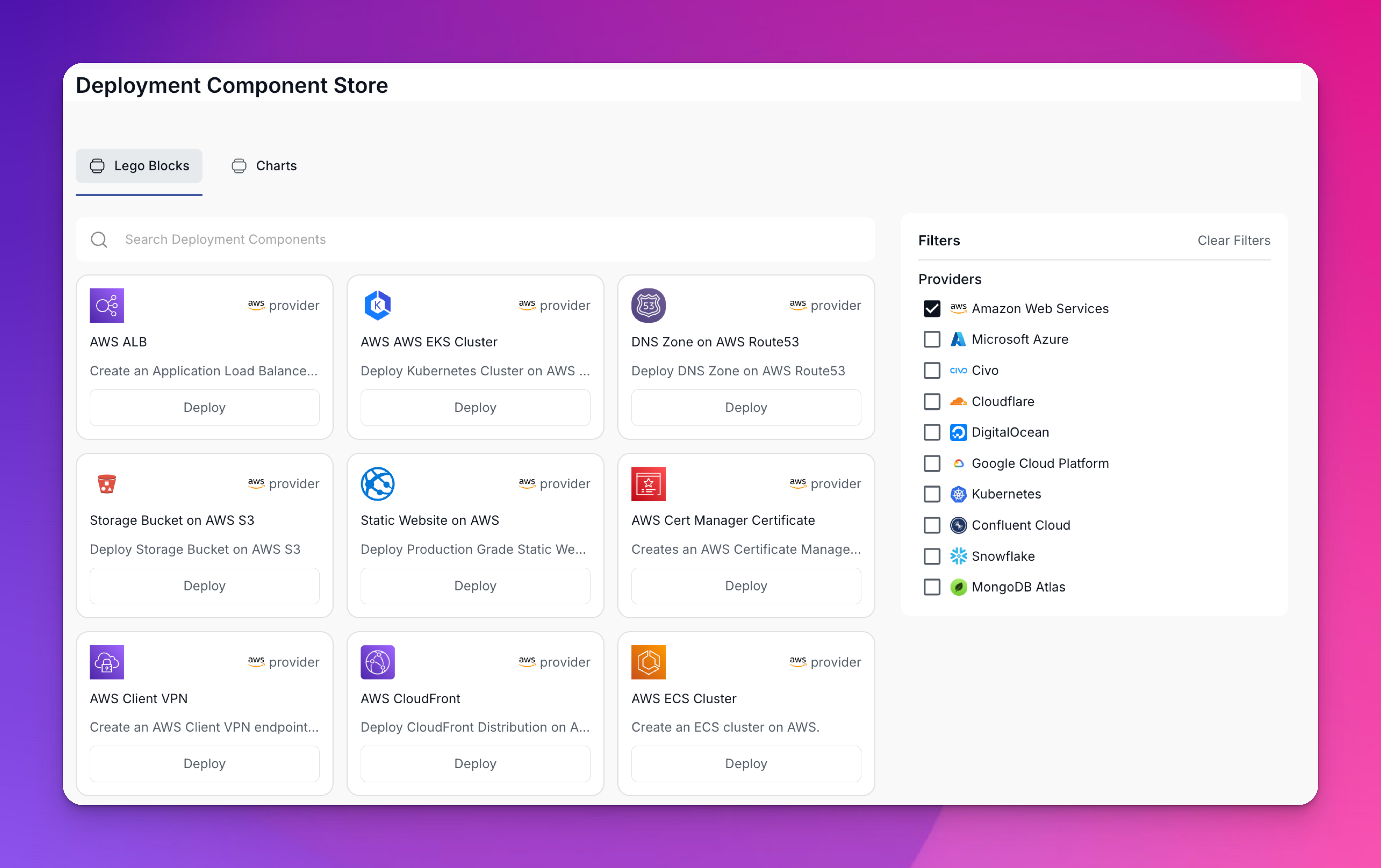
Find and Deploy a VPC
- In the search box, type "VPC"
- Filter by provider "AWS" to narrow results
- Click on AWS VPC to see details
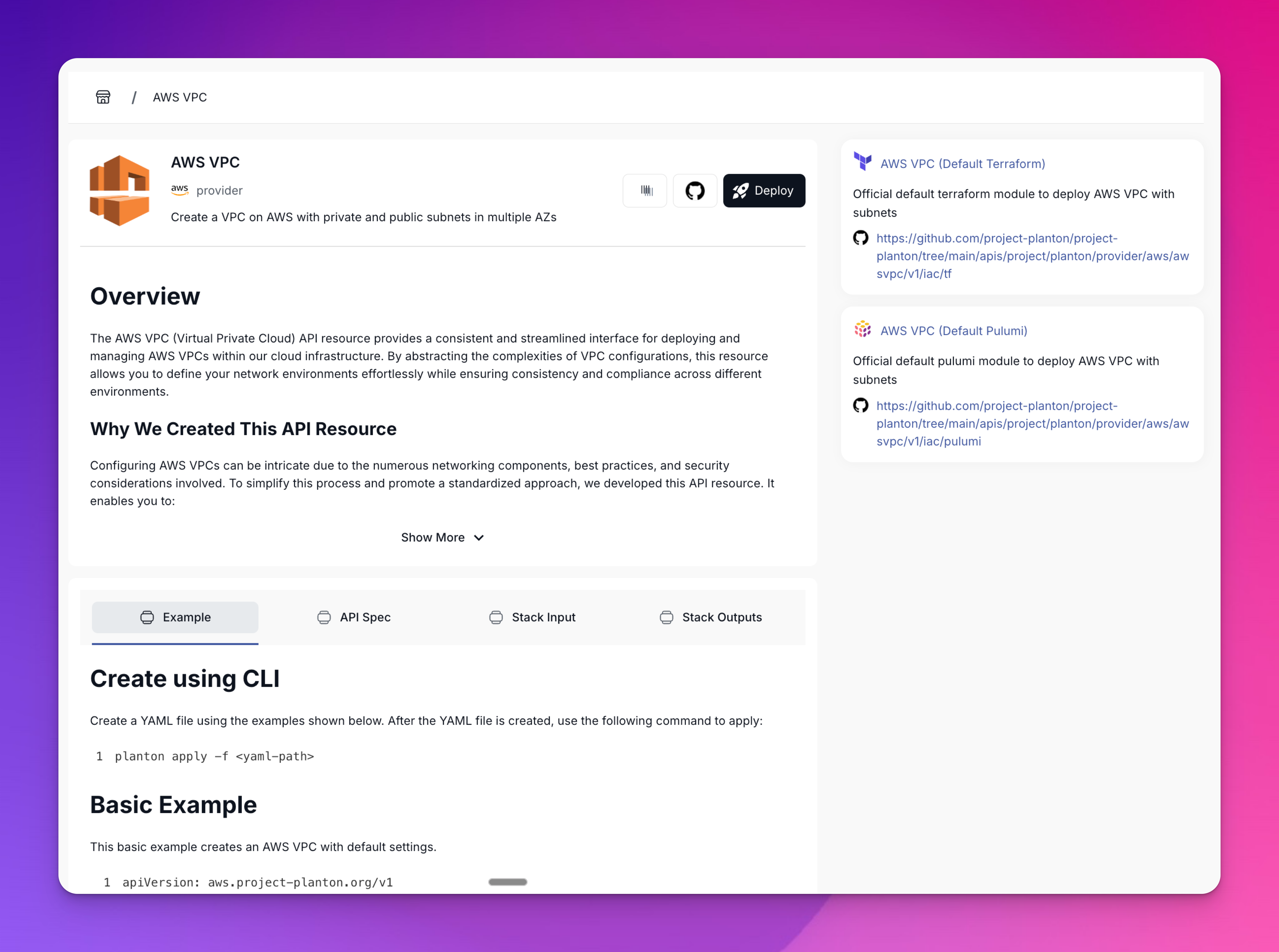
- Click "Deploy" button
- Fill in the configuration form:
- Name: "my-first-vpc" (this is metadata, not the AWS name)
- CIDR Block: "10.0.0.0/16" (or keep default)
- Other settings: Keep defaults for now
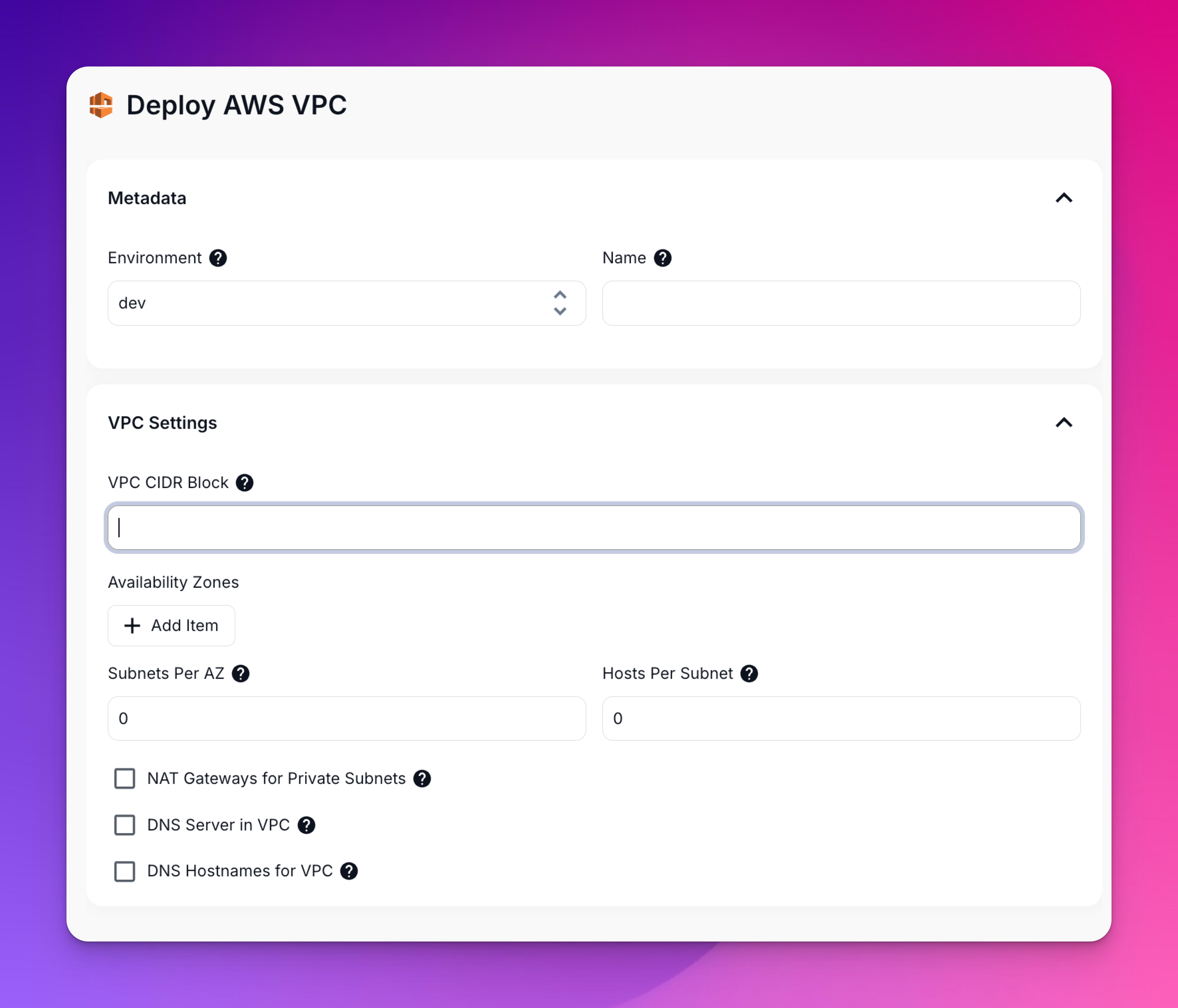
- Click "Deploy"
Watch Your Deployment
After clicking deploy:
- A Stack Job is created (this runs Terraform/Pulumi)
- You can watch real-time progress
- See each resource being created
- Get outputs when complete
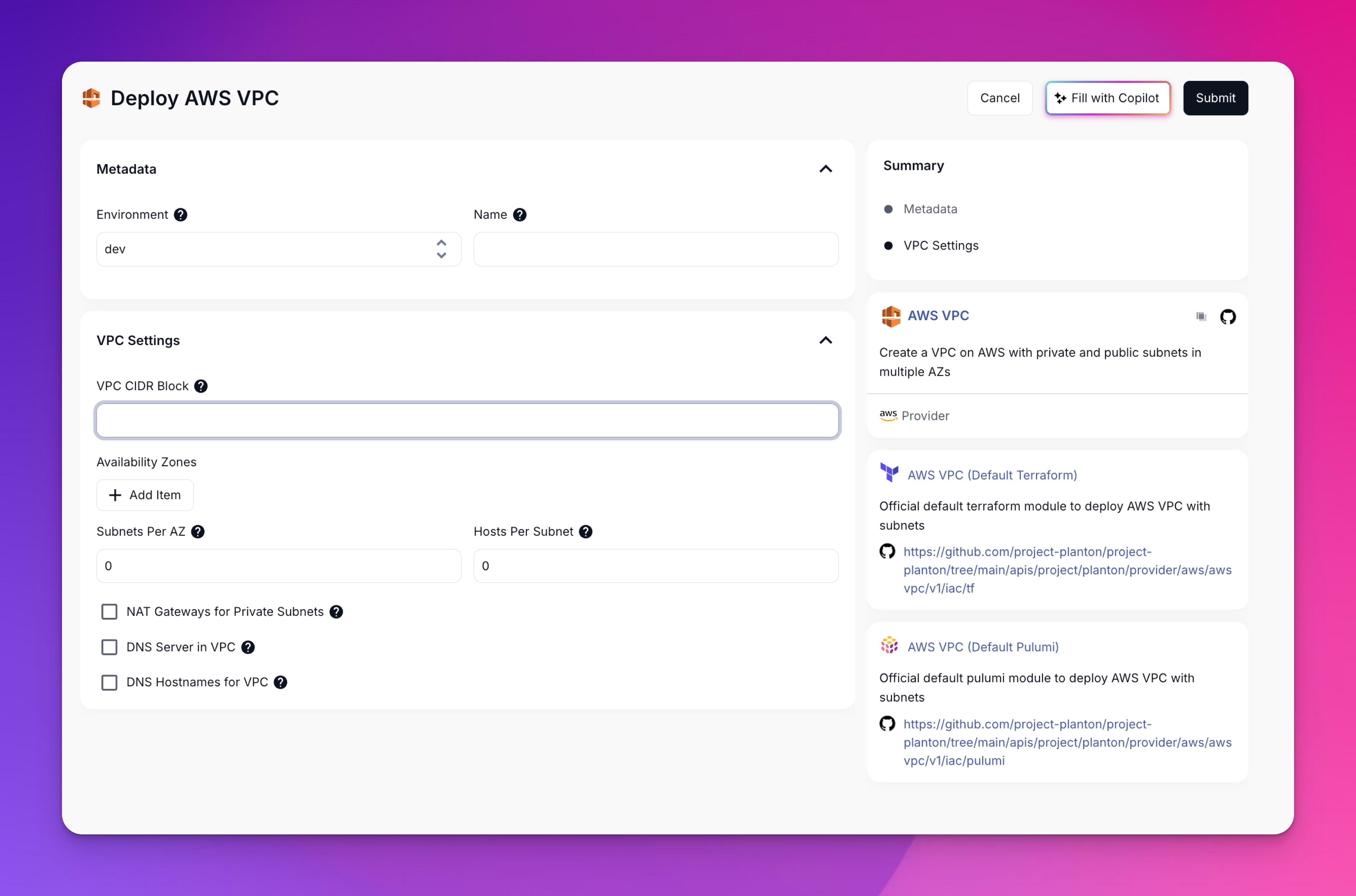
Typical duration: 2-3 minutes for a VPC
Step 6: Verify Your Deployment
Check Your Resources
- Go to InfraHub in the sidebar
- Click "Cloud Resources" tab
- You'll see your VPC listed

Click on the VPC to see:
- Full configuration
- Stack outputs (VPC ID, subnet IDs, etc.)
- Deployment history
- Real-time status
What Just Happened?
You've successfully:
- ✅ Created a Planton Cloud account
- ✅ Set up your organization
- ✅ Created an environment
- ✅ Connected your cloud account
- ✅ Deployed real infrastructure
All without writing any Terraform or cloud-specific code!
Next Steps: Build on Your Foundation
Deploy More Resources
Now that you have a VPC, try deploying:
- RDS Database: Managed PostgreSQL or MySQL
- EKS Cluster: Managed Kubernetes on AWS
- S3 Bucket: Object storage
Try an Infra Chart
Instead of individual resources, deploy a complete environment:
- Go to Component Store → Infra Charts tab
- Find "AWS ECS Environment"
- Deploy to get VPC + ECS Cluster + ALB + more
Screenshot Placeholder: Infra Charts showing AWS ECS Environment
Connect Git and Deploy Apps
- Go to Connections
- Connect GitHub or GitLab
- Create a Service in ServiceHub
- Push code and watch it deploy
Quick Reference
Platform Navigation
- Context Selector: Top-left, shows org/environment
- Component Store: Top-right, browse deployable resources
- InfraHub: Deploy and manage infrastructure
- ServiceHub: Deploy and manage applications
Common Tasks
- Switch Environment: Click context selector → choose environment
- Invite Team Members: Members section → Invite Members
- View Deployments: InfraHub → Cloud Resources or Infra Projects
- Check Usage: Billing section shows automation minutes
Getting Help
- Ask Copilot: AI assistant for deployment help
- Documentation: You're already here!
- Support: Available through the platform
Troubleshooting First-Time Issues
"I don't see a Create Organization button"
You might already be in an organization (check context selector). Log out and sign up with a new account if needed.
"My environment doesn't appear in connection authorization"
Make sure you've created the environment first. Connections can only be authorized for existing environments.
"Deployment failed with credentials error"
Check that:
- Your credentials are correct
- The connection is authorized for your environment
- The AWS/GCP/Azure user has necessary permissions
"I can't find the component I want"
Try:
- Remove filters and search again
- Check different cloud providers
- Look in Infra Charts for collections
What's Next?
Congratulations on your first deployment! Continue your journey:
- Platform Tour - Explore all platform features
- InfraHub Guide - Deep dive into infrastructure
- ServiceHub Guide - Deploy applications
- Team Collaboration - Invite your team
Remember: The platform is in beta, so you might encounter some rough edges. Your understanding and feedback help us improve!
You did it! 🎉 You've gone from zero to deployed infrastructure in minutes. This is just the beginning—there's so much more to explore. Welcome to Planton Cloud!
Next article
